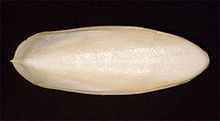- Cuttlebone
-
Cuttlebone, also known as cuttlefish bone, is a hard, brittle internal structure found in all members of the family Sepiidae, commonly known as cuttlefish.
Cuttlebone is composed primarily of aragonite. It is a chambered, gas-filled shell used for buoyancy control; its siphuncle is highly modified and is on the ventral side of the shell.[1] The microscopic structure of cuttlebone consists of narrow layers connected by numerous upright pillars.
Depending on the species, cuttlebones implode at a depth of 200 to 600 metres (660 to 2,000 ft). Because of this limitation, most species of cuttlefish live on the seafloor in shallow water, usually on the continental shelf.[2]
Contents
Human uses
In the past, cuttlebones were used in making polishing powder. The powder was added to toothpaste, and used as an antacid or as an absorbent.
Today, cuttlebones are commonly used as calcium-rich dietary supplements for caged birds, chinchillas, hermit crabs, and reptiles.[3]
Jewelry making
Because cuttlebone is able to withstand high temperatures and is easily carved, it serves as mold-making material for small metal casting for the creation of jewelry and small sculptural objects.
Jewelers prepare cuttlebone for use as a mold by cutting it in half and rubbing the two sides together until they fit flush against one another. Then the casting can be done by carving a design into the cuttlebone, adding the necessary sprue, melting the metal in a separate pouring crucible, and pouring the molten metal into the mold through the sprue. Finally, the sprue is sawed off and the finished piece is polished.[4]
3D visualisation of a Sepia cuttlebone by industrial micro computed tomography
Flight through the corresponding tomographic image stacks
-
Flight through the corresonding µCT image stack, section direction about 30°, lateral view.
-
Flight through the corresonding µCT image stack, section direction about 30°, top view.
-
Flight through the aligned image stack, lateral view.
-
Flight through the aligned image stack, top view.
-
Flight through the aligned image stack, top view, magnified section.
References
- ^ Rexfort, A.; Mutterlose, J. (2006). "Stable isotope records from Sepia officinalis—a key to understanding the ecology of belemnites?". Earth and Planetary Science Letters 247 (3–4): 212–212. Bibcode 2006E&PSL.247..212R. doi:10.1016/j.epsl.2006.04.025.
- ^ Norman, M.D. 2000. Cephalopods: A World Guide. ConchBooks.
- ^ Norman, M.D. & A. Reid 2000. A Guide to Squid, Cuttlefish and Octopuses of Australasia. CSIRO Publishing.
- ^ Casting Silver with Cuttlefish
- Neige, P. 2003. Combining disparity with diversity to study the biogeographic pattern of Sepiidae.PDF Berliner Paläobiologische Abhandlungen 3: 189–197.

This Cuttlefish article is a stub. You can help Wikipedia by expanding it.






